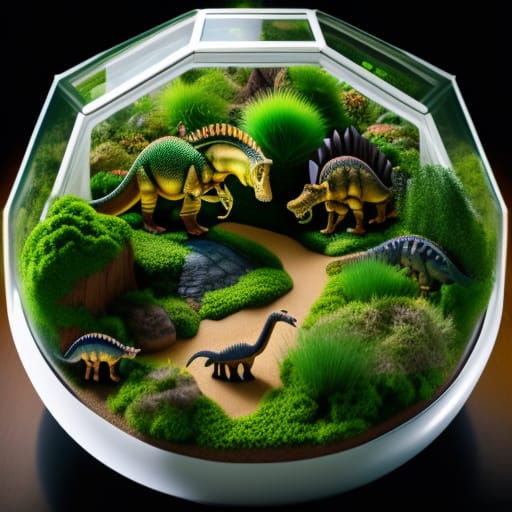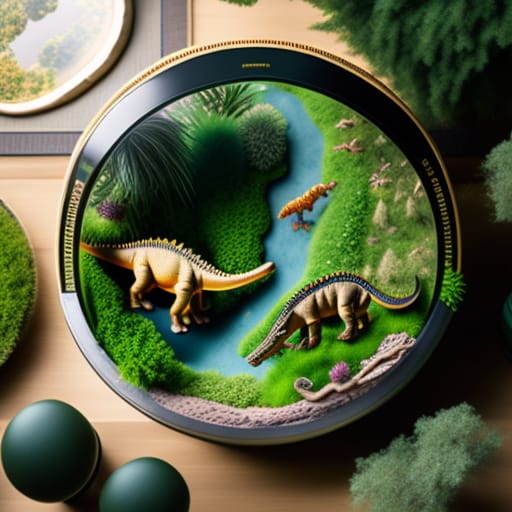Have you ever wondered what it would be like to have your own dinosaur habitat? With the National Geographic Dinosaur Terrarium kit, you can create a mesmerizing world filled with multicolor LED lights, real plants, and realistic-looking dinosaur figures right at home!

What is the National Geographic Dinosaur Terrarium?
The National Geographic Dinosaur Terrarium is an engaging science kit that allows you to build your own miniature dinosaur environment. Suitable for ages 5 and up, this hands-on activity lets kids learn about dinosaurs and plants while having fun.
This amazing light-up terrarium features:
- A plastic terrarium tank with a reversible backdrop of a Jurassic landscape on one side and black lava on the other
- A USB-powered multicolor LED light to illuminate the landscape
- Decorative rocks and colored pebbles form the terrain
- Dinosaur toy figures – Tyrannosaurus Rex, Triceratops, Velociraptor
- Faux prehistoric plant specimens like tropical ferns and cycads
- Real chia and ryegrass seeds sprout and grow
- A spray bottle and peat pellets for nurturing the plants
- Comprehensive instructions and educational content
With these components, you can easily construct an eye-catching dinosaur habitat teeming with plant and animal life straight from the Mesozoic Era.
Why Grow a Dinosaur Terrarium?
Building your own dinosaur terrarium offers many benefits:
- Learn about prehistoric life – Discover facts about dinosaurs, ancient plants, fossils, and the environments they lived in.
- Conduct science experiments – Grow living plants from seeds and observe their life cycle.
- Develop new skills – Follow step-by-step instructions to create your terrarium landscape. Gain confidence in building, troubleshooting, and problem-solving.
- Appreciate nature – Cultivate an interest in biology, botany and natural habitats.
- Relieve stress – Gardening and nurturing plants can lower anxiety and improve mood.
- Have fun! – Build an amazing dinosaur world and create imaginative adventures. A great STEM activity for kids.
Beyond the enjoyment of designing your own dinosaur habitat, this terrarium kit provides a hands-on educational experience about science and nature.
Key Features of the Dinosaur Terrarium
Let’s take a closer look at some of the standout features that make the National Geographic Dinosaur Terrarium so special:
Light-Up Terrarium Tank
The clear plastic tank has reversible backdrops – one side depicts a prehistoric landscape straight out of Jurassic Park with volcanoes, mountains, and palm trees. Flip it over to reveal a black “lava” motif for a different look.
At night, switch on the multicolor LED light to illuminate the tank and create an otherworldly ambiance. This light-up effect really makes the terrarium and its inhabitants come alive!
Realistic Dinosaur Figures
The kit includes 3 hand-painted dinosaur toys modeled after actual dinosaur species:
- Tyrannosaurus Rex
- Triceratops
- Velociraptor
These detailed PVC figures bring your terrarium to life. Use the dinosaurs and plastic plants to design dynamic scenes and tell imaginative stories.
Grow Living Plants
The terrarium lets you grow real chia and ryegrass plants using the included seeds. The seeds sprout quickly, allowing you to observe the entire life cycle of plants.
Caring for the plants by watering them with the spray bottle and ensuring they get enough light teaches responsibility. It also connects kids with nature.
Plus, the lush green plants look striking next to the dinosaurs and create a realistic slice of primordial jungle.
Fossils and Decorative Elements
Plastic replica fossils, rocks, colored pebbles, and artificial greenery come together to form the landscape. Design a natural-looking habitat with dirt paths, a riverbed, trees, and other fun scenarios. Get creative with the terrarium decoration!
The peat pellets make it easy to plant the chia and grass seeds at the right depth.
Educational Content
The kit includes a detailed color instruction manual that guides you through creating your terrarium step-by-step. It also provides interesting facts about the dinosaur figures, plants, and fossils.
Growing the terrarium and learning about its components offers many teachable moments. Kids can discover real-world science facts in a fun way.

How to Assemble the Dinosaur Terrarium
Building the National Geographic Dinosaur Terrarium is easy and enjoyable. Here is an overview of the basic assembly process:
Step 1 – Prepare the Terrarium Tank
Start by cleaning the plastic tank pieces with soap and water. Rinse and let them dry fully.
Choose which backdrop you want to use first – the green lush landscape or the black lava rock motif.
Slide the clear front panel into the back panel with your chosen backdrop locked into place.
Step 2 – Add Landscaping Elements
Now you can begin designing your dinosaur habitat!
First, cover the bottom of the tank with a layer of decorative rocks and colored pebbles. Create hills, valleys, cliffs, and other landforms.
Next, slide the plastic plants and faux fossil pieces into the pebble landscape to build up the environment. Get creative!
Sprinkle in pieces of green sheet moss for an extra prehistoric feel.
Step 3 – Plant Seeds
Prepare the peat pellets by placing them in water to moisten and expand.
Press a few chia and ryegrass seeds into each pellet, then arrange them in your terrarium.
Use the spray bottle to water the peat pellets. In a few days, you’ll see sprouts!
Step 4 – Add Dinosaur Figures
Now for the fun part – placing the 3 hand-painted dinosaur toys into your terrarium.
Create dynamic action scenes – a T-Rex chomping on a tree, raptors hunting prey, or a triceratops family. Re-arrange and tell new stories.
Position the dinosaurs next to the plants to really bring your prehistoric scene to life!
Step 5 – Power Up LED Light (Optional)
To take your terrarium to the next level, plug in the USB-powered LED light strip. This multicolor light illuminates the landscape to give it a truly magical ambiance.
Cycle through the light modes to find your favorite. The soft glow makes the entire scene pop!
And that’s all there is to it! In less than an hour, you can build this imaginative Mesozoic world. Maintain your terrarium by caring for the plants and decorating however you like.
Tips for Growing Your Dinosaur Terrarium
Follow these tips to successfully grow and maintain your National Geographic Dinosaur Terrarium:
- Place the terrarium near a window that receives bright, indirect sunlight. This allows the plants to thrive.
- Use the spray bottle to regularly mist the plants – 2-3 sprays daily is enough. Don’t overwater.
- If the tank walls get foggy, leave the lid off for a bit to allow ventilation and drying.
- Consider adding a thin layer of aquarium gravel on top of the pebbles to help retain moisture.
- Occasionally trim the sprouted ryegrass with scissors to encourage growth and tidy appearance.
- Swap out the backdrop panel to change up the look of your landscape.
- Have fun designing the habitat however you wish and creating stories with the dinosaurs! Let your imagination run wild.
With proper care, your chia and ryegrass will flourish for months, serving as a great science lesson about botanical life cycles. The dinosaur terrarium truly comes alive as a dynamic micro-world!
Educational Benefits of the Dinosaur Terrarium
As an interactive educational toy, the National Geographic Dinosaur Terrarium offers many benefits that support childhood learning and development:
STEM Skills
Building the terrarium habitat promotes critical thinking, problem-solving, and an understanding of science and nature. Kids can observe real plants sprouting from seeds and study the dinosaurs.
Motor Skills
Assembling the terrarium landscape and figures boosts hand-eye coordination and dexterity. Using the spray bottle also develops motor skills.
Responsibility
Caring for the live plants by regular misting and ensuring proper sunlight is a great lesson in responsibility for young children.
Creativity
Decorating the terrarium habitat, positioning the dinosaurs, and telling stories spark imagination and narrative thinking.
Botany Basics
Kids can learn plant biology basics like photosynthesis, growth cycles, and requirements for healthy plants.
Plus, just playing with this engaging STEM toy makes learning about science intrinsically fun!
Buying the National Geographic Dinosaur Terrarium
The National Geographic Dinosaur Terrarium is sold exclusively via the following retailers:
Amazon – MSRP $49.99
Barnes & Noble – MSRP $49.99
JOANN craft stores – MSRP $49.99
Toys R Us (online only) – MSRP $49.99
It makes for a great gift for children ages 5 and up who are interested in dinosaurs, habitat building, plants, and science.
Many families also enjoy putting these terrariums together as an educational activity to share quality time. So grab the dinosaur terrarium kit and let your inner paleontologist run wild!

Other Creative Terrarium Ideas
The National Geographic Dinosaur Terrarium inspires fun habitat building. But you can also design terrariums around other cool themes:
Space Terrarium – Use glow-in-the-dark decor to create an “alien” landscape with spaceships.
Ocean Terrarium – Use blue gravel and plastic corals and fish for an underwater world.
Fairy Garden – Miniature fairies, mushrooms, and flowers make a whimsical terrarium.
Jungle Terrarium – Craft a rainforest with tropical plants and plastic jungle animals.
Desert Terrarium – Use tan rocks and cacti to build an arid desert landscape.
Let your creativity run wild and build a unique terrarium ecosystem! The options are endless.
Frequently Asked Questions
How long do terrariums last?
With proper care, the plants and terrarium can survive for 2-4 months or longer before needing to be redone. The chia and ryegrass have short life cycles.
Can children build this alone?
Ages 8+ can assemble independently. Ages 5-7 will need some adult guidance and supervision for parts involving water and electricity.
Do the plants require sunlight?
Yes, place the terrarium near a window that receives bright indirect sunlight. Plants need light for photosynthesis.
What if plants develop mold or die?
Remove any dead plants and mold growth. Wipe away debris, sprinkle new seeds, and mist thoroughly to restore your terrarium.
Can you use real dirt instead of pebbles?
Yes, you may use potting soil or coconut coir instead of pebbles and moss for a more natural plant look.
Inspire Your Inner Paleontologist!
The National Geographic Dinosaur Terrarium is an exciting way to foster a love of science and nature. As you excavate this prehistoric world, imagine concepts coming to life:
The towering height of a T-Rex…
Ferns soaking up sunlight…
Velociraptor’s swift speed…
Building your own dinosaur habitat lets learning happen enjoyably through play.
So grab this educational STEM toy today and take your child’s curiosity and creativity back to the Mesozoic Era!